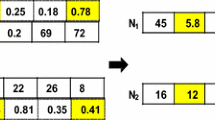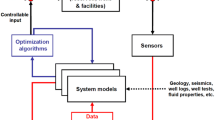Abstract
This paper presents the application of genetic algorithm (GA) to the history-matching problem. As history matching of VAPEX (vapour extraction) experiments is a complex, highly nonlinear, and non-unique inverse problem, a modified GA was developed to assist the history-matching process. Compared to conventional GA, the computational time in this modified GA approach was reduced by 71 %, and an excellent match between the simulation data and experimental data was achieved, with the error being less than 1 %. This study is focussed on automatic history matching of the VAPEX heavy oil recovery process.














Similar content being viewed by others
References
Castellini, A., Gullapalli, I., Hoang, V., & Condon, P. (2005). Quantifying uncertainty in production forecast for fields with significant history: A West African case study. International Petroleum Technology Conference, 21–23 November, Doha, Qatar.
Chamkalani, A., Zendehboudi, S., Chamkalani, R., Lohi, A., Elkamel, A., & Chatzis, I. (2013). Utilization of support vector machine to calculate gas compressibility factor. Fluid Phase Equilibria, 358, 189–202.
Chipperfield, A., Fleming, P., Pohlheim, H., & Fonseca, C. (1994). The MATLAB Genetic Algorithm Toolbox v1.2 User’s Guide. University of Sheffield, UK.
De Jong, K. A. (1975). An analysis of the behaviour of a class of genetic adaptive systems. Doctoral dissertation, University of Michigan Ann Arbour, MI, USA.
Grefenstette, J. J. (1986). Optimization of control parameters for genetic algorithms. IEEE Transactions on Systems, Man and Cybernetics, 16(1), 122–128.
Hart, W. E., & Belew, R. K. (1991). Optimizing an arbitrary function is hard for the genetic algorithm. Proceedings of the Fourth International Conference on Genetic Algorithms (pp. 108–114).
Haupt, R. L., & Haupt, S. E. (1998). Practical Genetic Algorithms. Hoboken: John Wiley & Sons, Inc.
Kerig, P. D., & Watson, A. T. (1987). A new algorithm for estimating relative permeabilities from displacement experiments. SPE Reservoir Engineering, 2(1), 103–112.
Kruger, W. D. (1961). Determining areal permeability distribution by calculations. Journal of Petroleum Technology, 13(7), 691–696.
Li, R., Reynolds, A. C., & Oliver, D. S. (2001). History matching of three-phase flow production data. SPE Reservoir Simulation Symposium, 11–14 February, Houston, Texas.
Lomeland, F., Ebeltoft, E., & Thomas, W. H. (2005). A new versatile relative permeability correlation. Toronto, Canada: International Symposium of the Society of Core Analysts.
Lorentzen, R. J., Flornes, K. M., & Naevdal, G. (2012). History matching channelized reservoirs using the ensemble Kalman filter. Society of Petroleum Engineers Journal, 17(1), 137–151.
Mantica, S., Cominelli, A., & Mantica, G. (2001). Combining global and local techniques for automatic history matching production and seismic data. SPE Reservoir Simulation Symposium, 11–14 February, Houston, Texas.
Mitchell, M. (1996). An Introduction to Genetic Algorithms, A Bradford Book The MIT Press.
Muhdar, T., & Masashi, K. (2013). Improvement of ship geometry by optimizing the sectional area curve with Binary-Coded Genetic Algorithms (BCGAs). The Twenty-third International Offshore and Polar Engineering Conference, 30 June-5 July, Anchorage, Alaska.
Reynolds, A. C., Li, R., & Oliver, D. S. (2004). Simultaneous estimation of absolute and relative permeability by automatic history matching of three-phase flow production data. Journal of Canadian Petroleum Technology, 43(3), 37–46.
Richmond, P. C., & Watson, A. T. (1990). Estimation of multiphase flow functions from displacement experiments. SPE Reservoir Engineering, 5(1), 121–127.
Roosta, A., Setoodeh, P., & Jahanmiri, A. (2012). Artificial neural network modeling of surface tension for pure organic compounds. Industrial and Engineering Chemical Research, 51(1), 561–566.
Sampaio, T. P., Ferreira Filho, V. J. M., & de Sa Neto, A. (2009). An application of feed forward neural network as nonlinear proxies for the use during the history matching phase. Latin American and Caribbean Petroleum Engineering Conference, 31 May-3 June, Cartagena de Indias, Colombia.
Schaffer, J.D., Caruana, R.A., Eshelman, L.J., & Das, R. (1989). A study of control parameters affecting online performance of genetic algorithms for function optimization. Proceedings of the third international conference on genetic algorithms (pp. 51–60).
Schulze-Riegert, R. W., Axmann, J. K., Haase, O., & Rian, D. T. (2002). Evolutionary algorithms applied to history matching of complex reservoirs. SPE Reservoir Evaluation and Engineering, 5(2), 163–173.
Shafiei, A., Dusseault, M. B., Zendehboudi, S., & Chatzis, I. (2013). A new screening tool for evaluation of steam flooding performance in Naturally Fractured Carbonate Reservoirs. Fuel, 108, 502–514.
Silva, P.C., Maschio, C., & Schiozer, D.J. (2006). Applications of the soft computing in the automated history matching. Canadian International Petroleum Conference, 13–15 June, Calgary, Alberta.
Sultan, A.J., Ouenes, A., & Weiss, W.W. (1994). Automatic history matching for an integrated reservoir description and improving oil recovery. Permian Basin Oil and Gas Recovery Conference, 16–18 March, Midland, Texas.
Sun, X., & Mohanty, K. K. (2005). Estimation of flow functions during drainage using genetic algorithm. Society of Petroleum Engineers Journal, 10(4), 449–457.
Tan, T. B., & Kalogerakis, N. (1992). A three-dimensional three-phase automatic history matching model: Reliability of parameter estimates. Journal of Canadian Petroleum Technology, 31(3), 34–41.
Thomas, L. K., Hellums, L. J., & Rehais, G. M. (1972). A nonlinear automatic history matching technique for reservoir simulation models. Society of Petroleum Engineers Journal, 12(6), 508–514.
Tokuda, N., Takahashi, S., Watanabe, M., & Kurose, T. (2004). Application of Genetic Algorithm to history matching for core flooding, SPE Asia Pacific Oil and Gas Conference and Exhibition, 18–20 October, Perth, Australia.
Vasanth Kumar, K. (2009). Neural network prediction of interfacial tension at crystal/solution interface. Industrial and Engineering Chemical Research, 48(8), 4160–4164.
Wathiq, J.M., & Al-Mudhafer (2013). Coupling programming of an adaptive genetic algorithm with reservoir flow simulation for infill oil well location optimization. SPE Western Regional & AAPG Pacific Section Meeting 2013 Joint Technical Conference, 19–25 April, Monterey, California, USA.
Watson, A.T., & Lee, W.J. (1986). A new algorithm for automatic history matching production data. SPE Unconventional Gas Technology Symposium, 18–21 May, Louisville, Kentucky.
Yang, P. H., & Watson, A. T. (1991). A Bayesian methodology for estimating relative permeability curves. SPE Reservoir Engineering, 6(2), 259–265.
Acknowledgments
The authors would like to thank the Petroleum Technology Research Centre (PTRC) and the Natural Sciences and Engineering Research Council (NSERC) for the financial support. The authors also wish to thank the anonymous reviewers for their detailed and valuable comments and suggestions.
Author information
Authors and Affiliations
Corresponding author
Additional information
The VAPEX process involves injection of vaporized hydrocarbon solvents into heavy oil and bitumen reservoirs; the solvent-diluted oil drains by gravity to a horizontal production well
Rights and permissions
About this article
Cite this article
Xu, S., Zhang, M., Zeng, F. et al. Application of Genetic Algorithm (GA) in History Matching of the Vapour Extraction (VAPEX) Heavy Oil Recovery Process. Nat Resour Res 24, 221–237 (2015). https://doi.org/10.1007/s11053-014-9255-7
Received:
Accepted:
Published:
Issue Date:
DOI: https://doi.org/10.1007/s11053-014-9255-7




